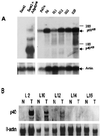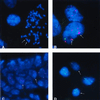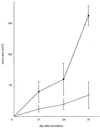AIS is an oncogene amplified in squamous cell carcinoma
- PMID: 10805802
- PMCID: PMC25851
- DOI: 10.1073/pnas.97.10.5462
AIS is an oncogene amplified in squamous cell carcinoma
Abstract
We and others recently isolated a human p53 homologue (p40/p51/p63/p73L) and localized the gene to the distal long arm of chromosome 3. Here we sought to examine the role of p40/p73L, two variants lacking the N-terminal transactivation domain, in cancer. Fluorescent in situ hybridization (FISH) analysis revealed frequent amplification of this gene locus in primary squamous cell carcinoma of the lung and head and neck cancer cell lines. (We named this locus AIS for amplified in squamous cell carcinoma.) Furthermore, amplification of the AIS locus was accompanied by RNA and protein overexpression of a variant p68(AIS) lacking the terminal transactivation domain. Protein overexpression in primary lung tumors was limited to squamous cell carcinoma and tumors known to harbor a high frequency of p53 mutations. Overexpression of p40(AIS) in Rat 1a cells led to an increase in soft agar growth and tumor size in mice. Our results support the idea that AIS plays an oncogenic role in human cancer.
Figures






References
-
- Hollstein M, Sidransky D, Vogelstein B, Harris C. Science. 1991;253:49–53. - PubMed
-
- Sidransky D, Frost P, Von Eschenbach A, Oyasu R, Preisinger A C, Vogelstein B. New Engl J Med. 1992;326:737–740. - PubMed
-
- Mao L, Sidransky D. Hum Mol Genet. 1994;3:521. - PubMed
-
- Kaghad M, Bonnet H, Yang A, Creancier L, Biscan J-C, Valent A, Minty A, Chalon P, Lelias J-M, Dumont X, et al. Cell. 1997;90:809–819. - PubMed
-
- Gong J G, Costanzo A, Yang H Q, Melino G, Kaelin W G, Jr, Levrero M, Wang J Y. Nature (London) 1999;399:806–809. - PubMed
Publication types
MeSH terms
Substances
Grants and funding
LinkOut - more resources
Full Text Sources
Other Literature Sources
Medical
Research Materials
Miscellaneous

